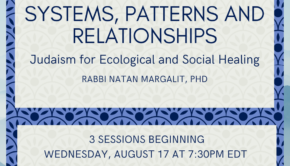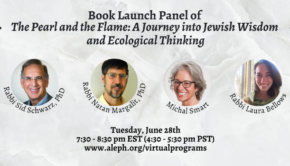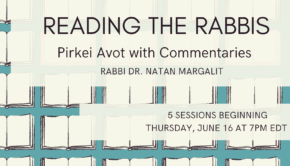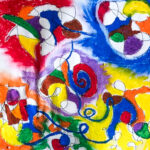Book Club Questions for “The Pearl and the Flame”
The Pearl and the Flame deals with how to save the planet, make Judaism vital and relevant, make society healthier and connect to the natural world — plenty of good topics for discussion! To help you get started on these discussions we’re offering this guide for reading groups or book clubs. Use it to enrich your reading and strengthen your community. Enjoy.
—
1. This book is described as a “journey.” How does the author’s personal and spiritual journey reflect the book’s themes of fragmentation versus integration, either/or versus both/and? Do you see these themes in your own life’s journey?
2. In the Prologue the author is faced with an either/or choice which threw him for a loop, causing him months of spiritual paralysis and confusion until he ultimately rejected the either/or question. Have you ever faced an either/or choice between tradition or modernity? Between belonging or freedom? Between personal meaning and scientific truth?
3. How do the banyan trees which the author describes in his childhood home come to represent both his sense of isolation and his love of a mysterious life force in nature? What places in nature have a special meaning for you?
4. Margalit notes his early childhood attraction to the book The Call of the Wild as an attraction to a wildness he senses in nature, partly in frustration with the conventionality of his social world. Does The Pearl and the Flame offer an escape from social conventions or does it attempt to integrate a wildness or fluidity into social life? If so, how?
5. There is a continuation of the midrash of the “Stringing Pearls” which features another rabbi who says he’s afraid of the fire when he strings words together. He is answered by a third rabbi who says, “some people are stringers, and some people are drillers. I’m both a stringer and a driller.” What do you think is the difference between a “stringer” and a “driller” in interpreting texts? In one’s approach to life? Do we need both?
6. The author identifies river valley civilizations such as (the biblical characterization of) ancient Egypt and Mesopotamia as “cultures of control” and also cultures which create waste by pushing out those things and people who don’t fit with their sense of control. Do you experience our modern world as having similar tendencies? How so?
7. Margalit identifies Ancient Israel as a “culture of relationship.” How did the rabbis who created the Talmud, Mishnah and Midrash continue that culture of relationship? How do you experience studying these classic Jewish texts as different from Western literature or philosophy? Do you think you may approach these texts differently after reading The Pearl and the Flame? How so?
8. In the biblical texts discussed in Chapter Six, “Life Emerges,” Margalit discusses ancient customs such as tearing one’s clothes and letting one’s hair grow wild as symbols of death. The Kohen (Priest) as a symbolic representative of the life of the People was mandated to maintain their clothes untorn and their hair neatly cut and covered. Do we today use clothing and hair styles as symbols? What are the messages that we send with our choices about these and other bodily practices?
9. Margalit identifies how emergence (Minyan) is a key to life. Starting from a single cell and up to a minyan coming together into community, or a play or story that suddenly “clicks” into a life of its own, he uses “life” in a broader sense than just physically living or not. Have you experienced times when you felt more or less alive? What types of situations make you feel really alive?
10. The Pearl and the Flame highlights the way many aspects of our lives can be better understood as systems. As a society we are starting to make this shift toward seeing systems, but it isn’t always smooth. For example, systemic racism is a major topic in the news. Many people misunderstand terms like systemic racism because it can’t be seen “in” an individual. People mock the idea saying, for example, “Is a baby born a racist?!” How can a better understanding of systems as emergent phenomenon, that can’t be seen under a microscope but which shape our lives help people to better understand issues like racism, gun violence, climate change, addiction or other major issues?
11. Have you experienced “Minyan/Emergence” in a creative activity such as writing, dancing, singing or even gardening, cooking or baking or other activities? How would you describe your experience of something “coming alive?”
12. In Chapter Seven, “Agriculture, Culture, Health and Holiness” Margalit quotes Wendell Berry in describing how a healthy farm is built on “solving for pattern” – that is, seeing how animals are related to the plants, which are related to the community, which are related to the land and the weather—all the relationships need to be considered to come up with healthy solutions. What are examples in your life where you can see the utility in “solving for pattern”?
13. Malcolm Gladwell has made terms like “tipping point” and “going viral” popular and they arguably have helped shift people’s consciousness into a more systems thinking mode. Discuss how “Mitzvah” as a small action that can have huge results might connect Judaism with those popular terms. Are there things that you do such as voting or volunteering which you might start to think of as “modern mitzvot”?
14. Natan’s life changed dramatically when Ilana decided to come to the wedding in New Paltz and spend the Shabbat with him. Have you had experiences where a decision (either your own or someone else’s) has dramatically changed your life?
15. Margalit connects the idea of “mitzvah” with non-linear change—things can happen in sudden, unexpected ways, and a small action can make a big difference. He argues that this is a cause for hope. What is your experience of hope (or hopelessness) in our troubled times? Did reading The Pearl and the Flame help to give you a framework for hopefulness
16. The concept of Nestedness / Mikdash speaks about how we can overcome either/or dilemmas by understanding that we all have of many nested identities. We are individuals, families, communities, members of a religion or ethnic group, members of the human species, part of the world of nature and the planet. How do you experience these or other nested identities?
17. Margalit claims that the idea of Nestedness / Mikdash helps us understand how we can have fruitful civil discourse with people with whom we disagree, what he calls “machlokhet l’shem Shamayim” an argument for the sake of Heaven. How could this concept help us improve our conversations in our families, communities, workplace, schools, places of worship or politics?
18. Margalit distinguished between the ultimate, unknowable God which is the Source of All, and the way that God manifests in the world. Can we say that a Sanctuary / Mikdash is place / time that is guarded by permeable boundaries in which we can experience God manifesting in our world? He talks about our hearts being one level of sanctuary, and an ecosystem can also be a sanctuary where God is manifest. What does this say about our responsibility for helping God become more manifest in our world?








